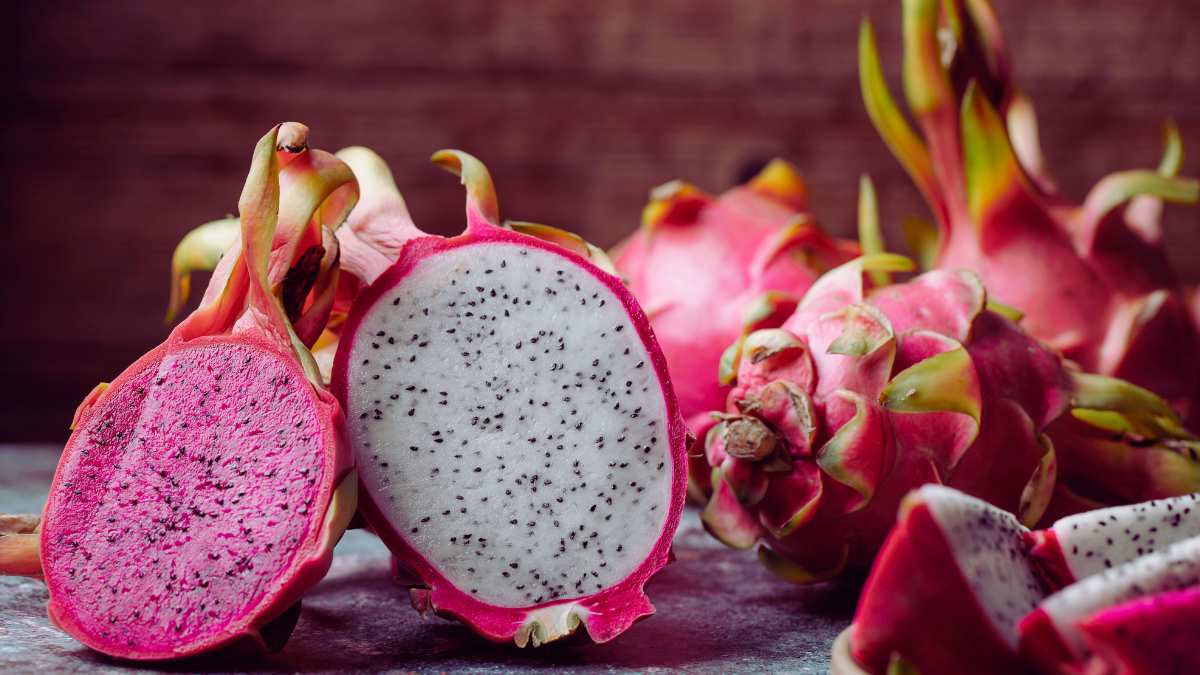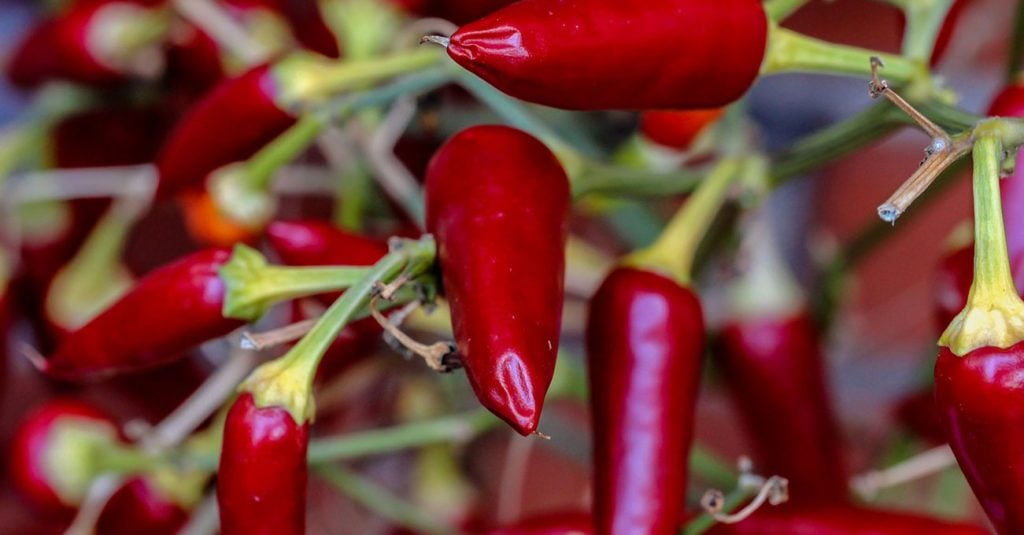Dragon fruits have been taking the culinary and health-conscious communities by storm, captivating both taste buds and imagination. With their vibrant colors and unique appearance, dragon fruits have become a must-try for food enthusiasts, health aficionados, and those seeking to expand their palate.
Dragon fruits, also known as pitayas (Hylocereus undatus), belong to the cactus family and are native to tropical regions, including Central and South America, as well as Southeast Asia. While they may seem like mythical fruits plucked straight out of a fairytale, their allure lies in their remarkable taste, nutritional benefits, and versatile culinary applications.
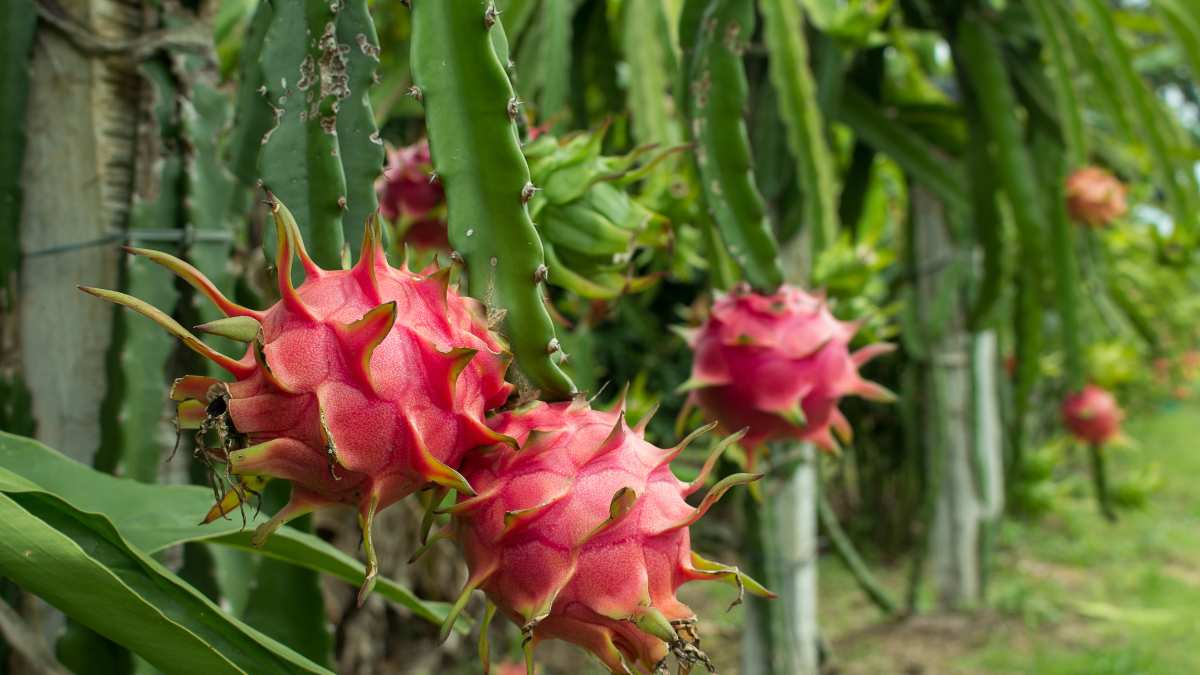
When it comes to dragon fruits, you’ll encounter a stunning array of varieties and colors. From the traditional and widely recognized pink-skinned fruit with white flesh to the lesser-known yellow variety that boasts a sweeter flavor profile, dragon fruits offer a sensory adventure that will leave you craving more.
Whether you’re a seasoned foodie or just curious about exploring new flavors, this guide will take you on an exciting journey through the dragon fruit realm. We’ll delve into the different types of dragon fruits, uncover their incredible health benefits, reveal tips for growing your own dragon fruit plants, and provide delectable recipes to tantalize your taste buds.
So, let’s discover their nutritional wonders and learn how to savor these tropical delights in various mouthwatering ways. Brace yourself for a delicious adventure that will leave you enchanted by the magic of dragon fruits!
Types and Varieties of Dragon Fruits
As an avid fan of dragon fruits, I can’t wait to introduce you to the captivating world of these delectable fruits. Get ready to explore the various types and enticing varieties that will make your taste buds dance with delight. Let’s dive right in!
The Yellow Dragon Fruit: A Sweet Surprise
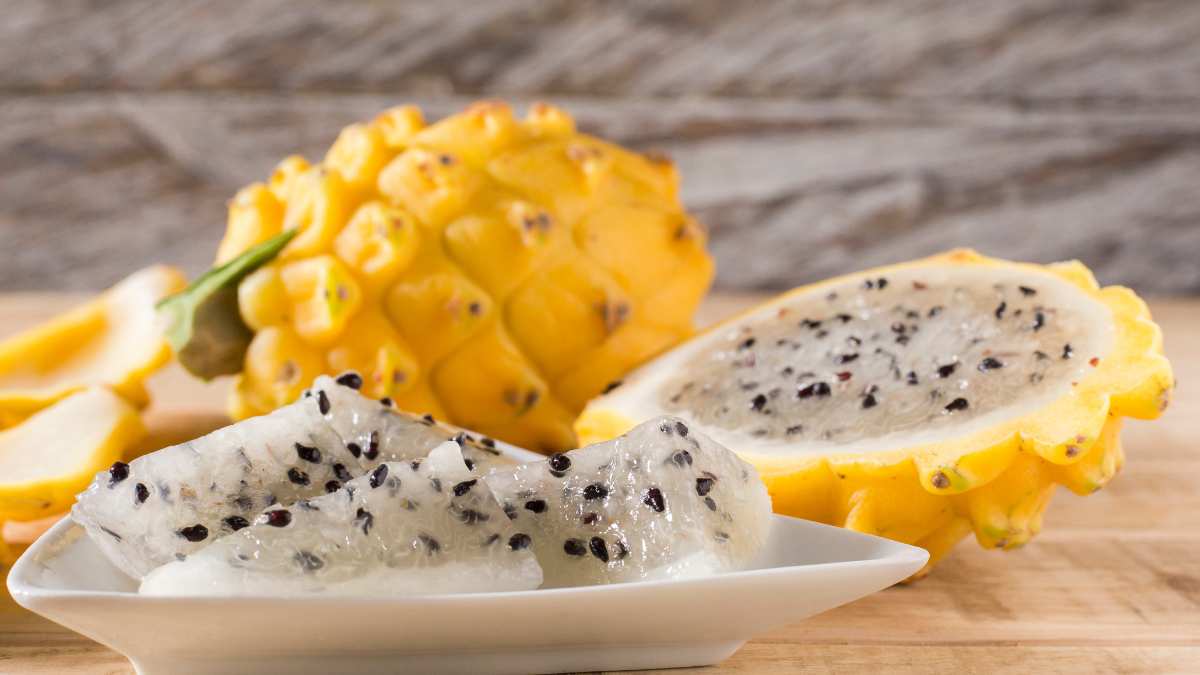
If you’re craving a tropical treat with a touch of sweetness, the yellow dragon fruit is your go-to choice. Its vibrant yellow skin hides a treasure trove of succulent, juicy flesh that’s guaranteed to satisfy your fruity cravings.
The Ravishing Red Dragon Fruit: A Feast for the Senses
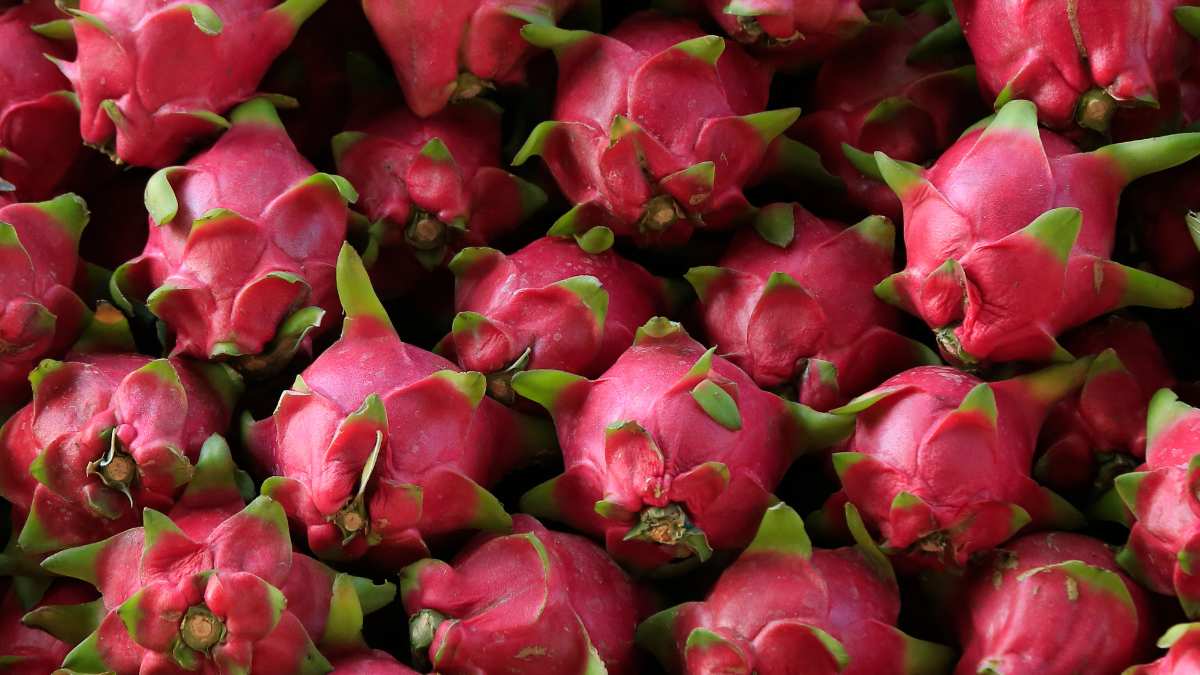
Prepare to be mesmerized by the red dragon fruit variety. With its vibrant crimson skin and stunning white or deep magenta flesh speckled with tiny black seeds, this variety is an absolute feast for the senses. Its subtly sweet and refreshing flavor will have you coming back for more.
Pretty in Pink, Mellow in Flavor
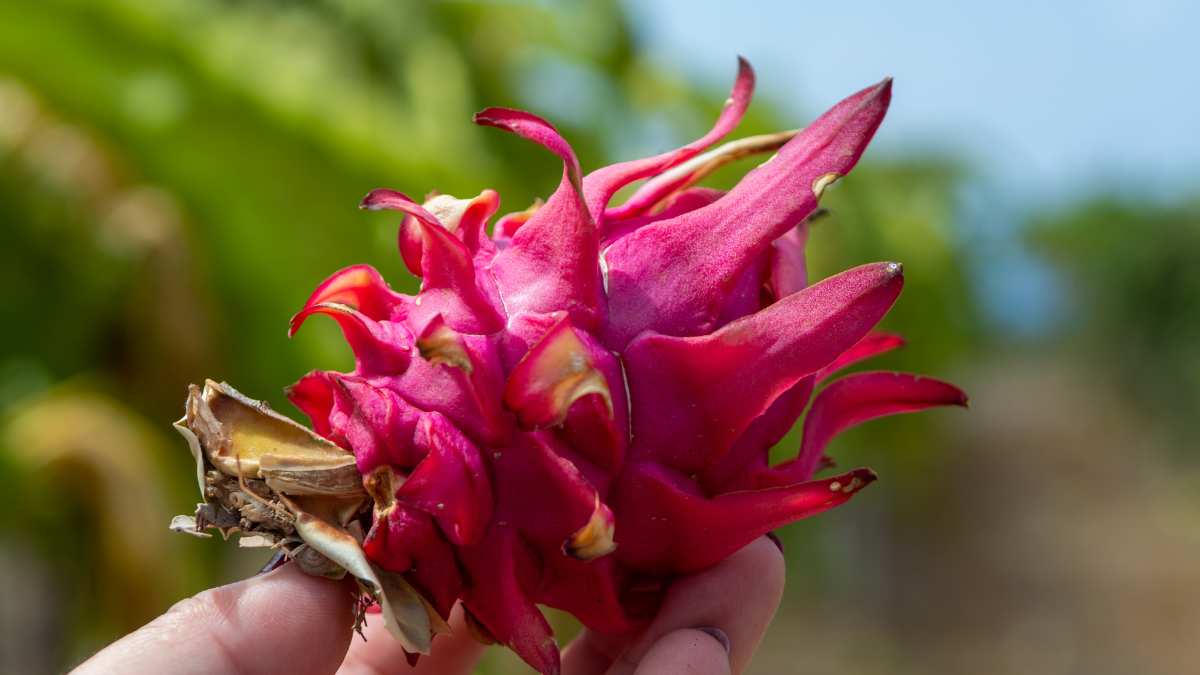
Among the most well-known and widely available dragon fruit varieties is the pink dragon fruit. Its striking pink skin and white flesh adorned with tiny black seeds create a beautiful contrast that’s hard to resist. When you take a bite, you’ll discover a delicate, mellow flavor with a hint of sweetness.
The Enchanting Purple Dragon Fruit: A Tropical Delight
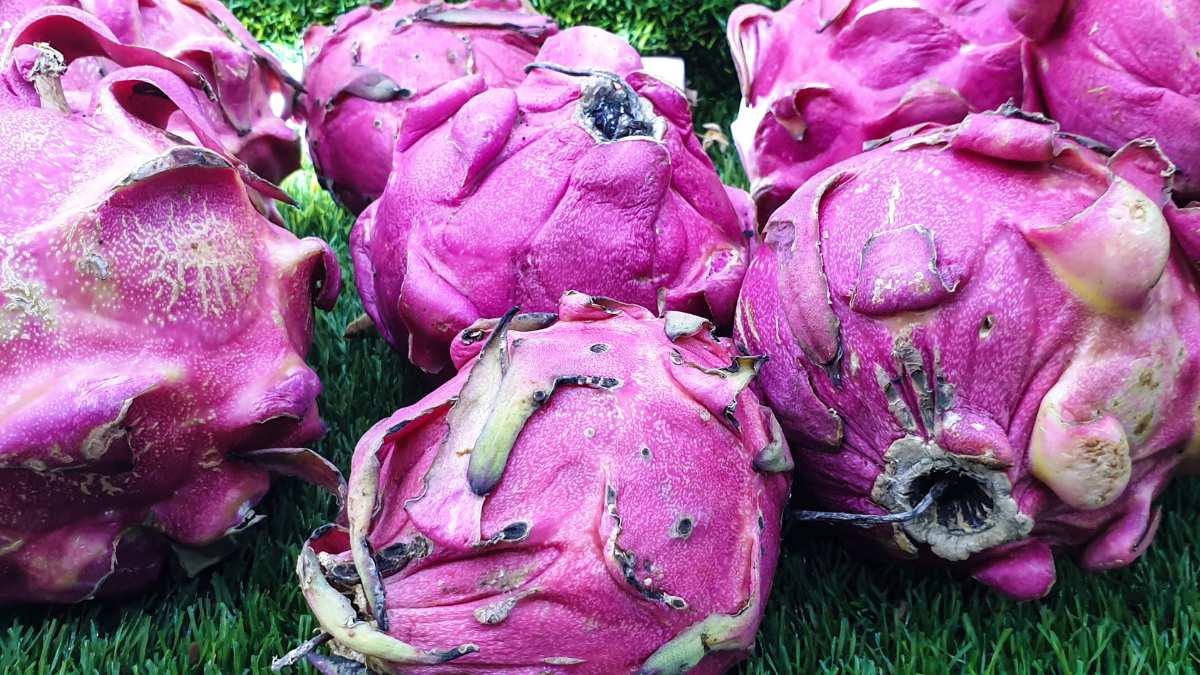
If you’re seeking a dragon fruit variety that’s as visually stunning as it is delicious, look no further than the purple dragon fruit. With its mesmerizing deep purple or magenta skin and luscious white or pink flesh, this variety is a tropical delight that’s sure to impress.
The Blue Dragon Fruit: A Rare Gem
While not as commonly found as the other varieties, the blue dragon fruit deserves special mention. Its distinctive blue or purple skin and vibrant, juicy flesh make it a rare gem among dragon fruits. If you ever come across this extraordinary variety, don’t hesitate to give it a try for a truly unique experience.
Let’s prepare our taste buds for a delightful adventure through their flavors and textures. Get ready to learn about the astonishing health benefits these fruits offer, as well as discover tips for growing your own dragon fruit plants.
The green dragon fruit:
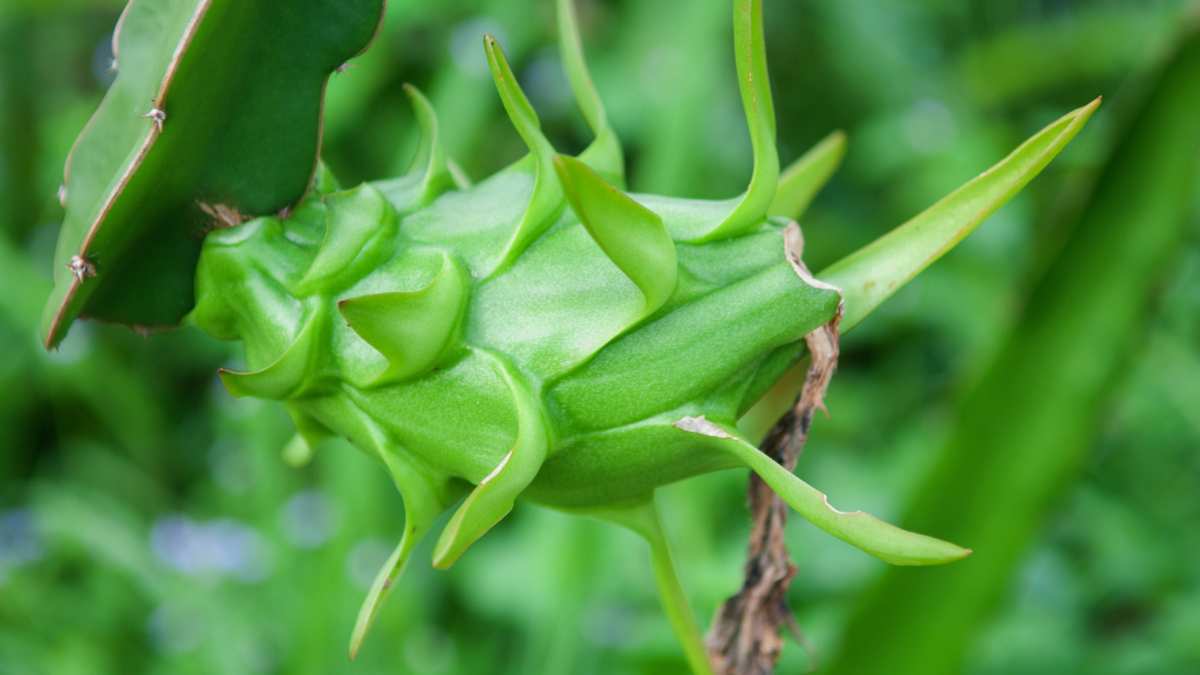
This variety has green skin and white flesh with black seeds. It has a mild and sweet flavor and is often used for making jams or juices.
The orange dragon fruit:
This variety has orange skin and white flesh with black seeds. It has a tangy and citrusy flavor and is rich in vitamin C.
The black dragon fruit:
This variety has dark purple or black skin and white flesh with black seeds. It has a strong and sour flavor and is high in antioxidants.
The white dragon fruit:
This variety has white skin and white flesh with black seeds. It has a bland and neutral flavor and is often mixed with other fruits or sweeteners.
Nutritional and Health Benefits of Dragon Fruits

Ah, dragon fruits! Not only are they a feast for the eyes and taste buds, but they also pack a powerful nutritional punch. Let’s explore the incredible health benefits that make dragon fruits a fantastic addition to your diet. Get ready to discover the wonders they hold!
A Nutrient Powerhouse
Dragon fruits are rich in essential vitamins and minerals that contribute to overall well-being. Packed with vitamin C, they support a healthy immune system and help ward off those pesky colds and flu. Plus, dragon fruits are a great source of antioxidants, which combat harmful free radicals in the body and promote cellular health.
Dragon fruit nutrition facts
| Calories: | Approximately 60 |
| Carbohydrates: | Around 9 grams |
| Fiber: | Roughly 1 gram |
| Protein: | About 1 gram |
| Fat: | Nearly 0 grams |
| Vitamin C: | Provides 20% of the recommended daily intake |
| Calcium: | Contains around 1% of the recommended daily intake |
| Iron: | Provides about 1% of the recommended daily intake |
Hydration Hero
With their high water content, dragon fruits are a refreshing choice to help keep you hydrated. Staying properly hydrated is crucial for optimal bodily functions, including digestion, circulation, and temperature regulation. So, savoring a juicy dragon fruit can help quench your thirst and keep you feeling revitalized.
Digestive Delight
If you’re looking to improve your digestion, dragon fruits are here to lend a helping hand. These delightful fruits are packed with dietary fiber, which promotes healthy digestion and helps prevent constipation. Including dragon fruits in your diet can contribute to a happy and balanced digestive system.
Heart-Healthy Goodness
Keeping your heart in top shape is essential for a healthy life, and dragon fruits can assist in that mission. They are low in cholesterol and contain beneficial monounsaturated fats that help maintain healthy cholesterol levels. Additionally, their potassium content supports proper heart function and helps regulate blood pressure.
Glowing Skin and Hair
Who doesn’t want radiant skin and luscious locks? Dragon fruits can contribute to a healthy complexion and beautiful hair. Their antioxidants and vitamin C help combat free radicals, promoting youthful-looking skin and aiding in collagen production. So, make dragon fruits your beauty secret for a natural glow from within.
Weight-Wise Choice
If you’re watching your weight, dragon fruits can be your ally on the journey to a healthier you. These fruits are low in calories and high in fiber, making them a satisfying snack that keeps you feeling full for longer. So, indulge guilt-free in the deliciousness of dragon fruits while supporting your weight management goals.
Anti-Inflammatory Benefits
Inflammation can wreak havoc on our bodies, leading to various health issues. Luckily, dragon fruits possess anti-inflammatory properties thanks to their antioxidants. Incorporating dragon fruits into your diet can help reduce inflammation and promote overall well-being.
With their impressive nutritional profile and array of health benefits, dragon fruits are a true superfood.
Growing and Caring for Dragon Fruit Plants
Let’s dive into the exciting realm of growing and caring for these magnificent plants. Whether you have a green thumb or are a budding gardening enthusiast, get ready to unlock the secrets to cultivating your very own dragon fruit oasis.
How to propagate Dragon Fruit ( Pitaya)
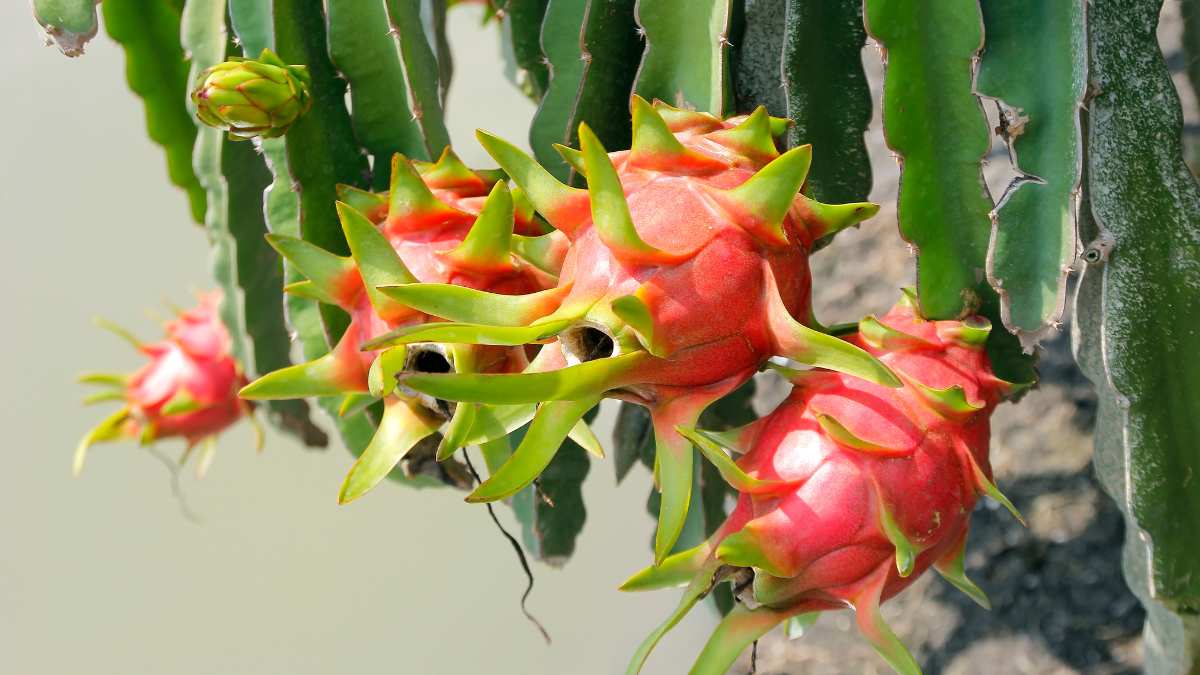
There are several methods you may use to grow dragon fruit. Although you may grow it from seed, this is not the most dependable way because the fruit’s and stem’s properties can vary quite a little.
In addition, it may take the plant up to 7 years to bear fruit! Asexual reproduction through stem cuttings is a significantly superior method of pitaya propagation.
Start by making a slanted cut at the stem’s base using stem pieces that are between 6 and 15 inches (12 to 38 centimeters for our metric friends) in length. After applying a fungicide, the cuttings should be left to dry out and recover for approximately a week in a shaded area.
After that, you can either plant them in the ground or in pots with well-draining soil. Although it’s not absolutely essential, some people choose to apply a rooting hormone on the cuttings to aid in their growth.
Pitaya cuttings may grow up to 1.2 inches (3 cm) every day, which is wonderful news. After planting, many cuttings will begin to bear fruit within 6 to 9 months. They will develop into trellis supports more rapidly if you utilize longer cuttings than shorter ones.
Try transplanting pitaya as well if you’re feeling daring. Although this approach is uncommon, it has certain benefits. By grafting, you may choose rootstocks that are more suited to certain problems and soil conditions. However, stem cuttings are the best option for the majority of people.
One thing to keep in mind is that it often takes cuttings 4 to 6 months to establish a strong root system before they are prepared for planting. Your pitaya plants, however, will be well on their way to producing wonderful fruit once they have established themselves.
Choosing the Right Location
Select a sunny spot in your garden or a well-lit area if you’re growing dragon fruit indoors. These plants thrive in warm and tropical climates, so ensure they receive ample sunlight for at least six hours a day. If you live in a cooler region, consider growing dragon fruits in containers that can be moved indoors during colder months.
Soil and Drainage Requirements
Dragon fruits prefer well-draining soil to prevent waterlogging and root rot. Sandy soil enriched with organic matter is ideal for their growth. Ensure the soil pH is slightly acidic to neutral, ranging between 6 and 7.
Planting Dragon Fruit Cuttings
To start your dragon fruit journey, obtain healthy cuttings from a mature dragon fruit plant. Plant the cuttings in a cactus or well-draining potting mix, burying them about one-third of their length. Provide support with stakes or trellises to help the plants climb and flourish.
Watering and Irrigation
When it comes to watering dragon fruit plants, it’s important to strike a balance. Water the plants regularly, especially during the growing season, but avoid overwatering. Allow the soil to dry out between watering sessions to prevent root rot.
Fertilization and Nutrient Requirements
To keep your dragon fruit plants happy and thriving, provide regular fertilization. Apply a balanced, slow-release fertilizer during the growing season. Additionally, supplement with phosphorus-rich fertilizer to promote blooming and fruit production.
Pruning and Maintenance
Pruning plays a vital role in maintaining healthy and productive dragon fruit plants. Remove any dead or damaged branches to prevent the spread of diseases. Prune the plants to control their size and shape, and encourage new growth and flowering.
Protecting from Frost and Cold Temperatures
If you live in an area prone to frost or cold temperatures, it’s essential to protect your dragon fruit plants. Cover them with blankets or plant covers during cold spells to shield them from freezing temperatures. Consider moving potted plants indoors or into a greenhouse for added protection.
These essential tips for growing and caring for dragon fruit plants will help you to be well on your way to cultivating a thriving and bountiful dragon fruit oasis.
Enjoy watching your plants flourish, and look forward to the day when you can harvest your own delectable dragon fruits.
How to Build Dragon Fruit Trellising and Support?
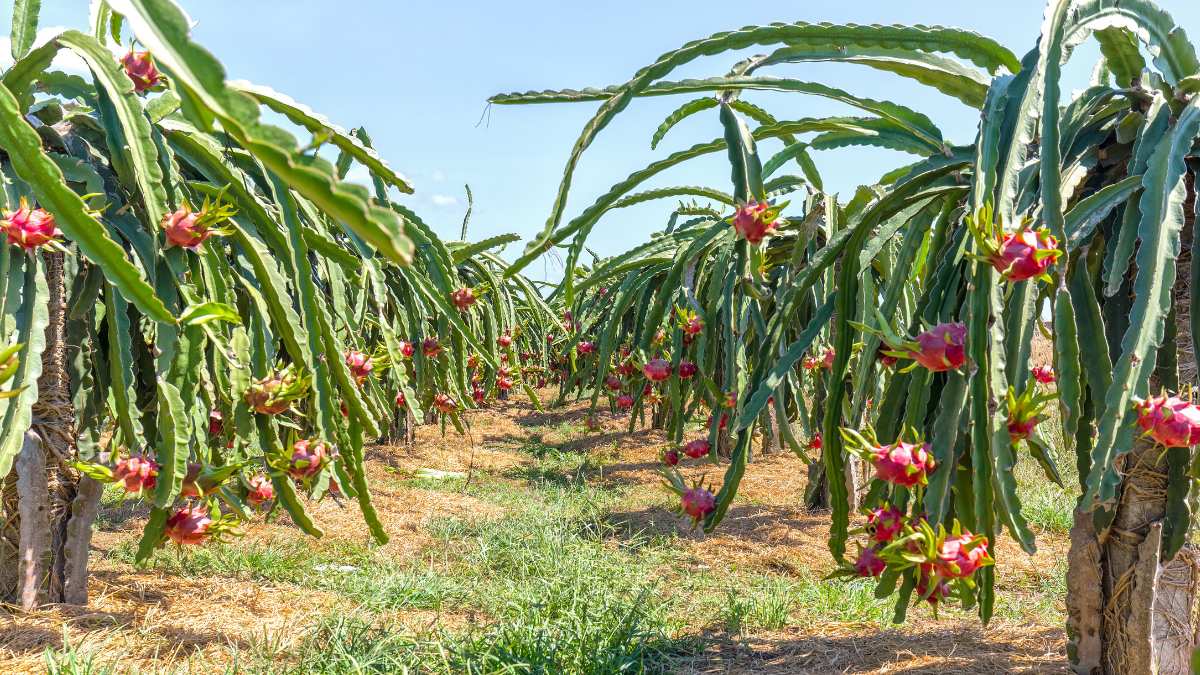
Dragon fruits are climbing plants that benefit from support as they grow.
Install trellises or sturdy stakes near the plants to provide a structure for them to climb. This not only promotes proper growth but also makes harvesting the fruits easier.
To build dragon fruit trellising and support, you will need some materials, such as
- Wood,
- Timber
- Supported box
- Poly Pipe
- Cement post (You can buy pre-made concrete fence posts)
- Metal or PVC pipes, as well as
- Screws, nails, or wire.
You can either follow a pre-made design or create your own according to your space and preferences. The main idea is to create a sturdy and stable frame that can support the weight of the plants and fruits. You can also add crossbars or horizontal wires to create more space for the plants to spread out.
Once you have built your trellising and support, you can attach the dragon fruit plants to them using soft ties or clips. Make sure to check on them regularly and adjust the ties or clips as needed. By providing adequate trellising and support for your dragon fruit plants, you can ensure their optimal health and productivity.
Harvesting and Consuming Dragon Fruits
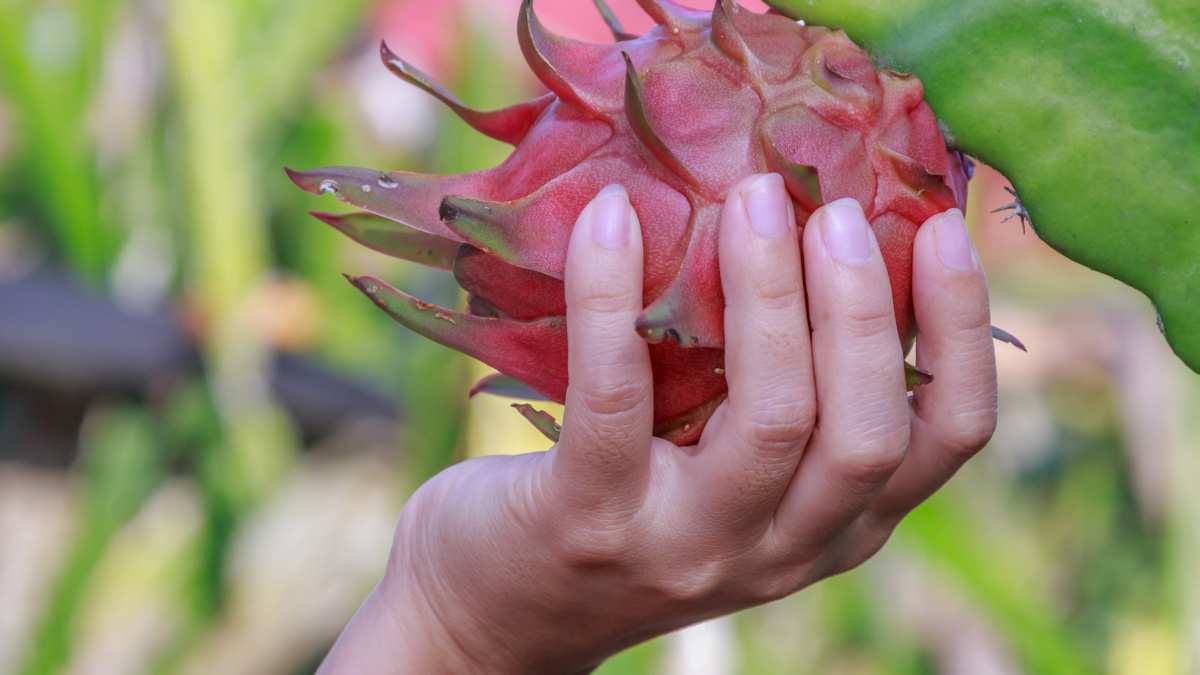
That might be the moment you’ve been waiting for!
It’s time to reap the rewards of your labor and indulge in the sweet delight of fresh dragon fruits. Here, we’ll explore the art of harvesting these marvelous fruits and discover the many mouthwatering ways to enjoy them. Get ready to embark on a flavorful journey like no other!
Determining Ripeness
Knowing when your dragon fruits are ripe for the picking is key to experiencing their full flavor and juiciness. Look for vibrant and evenly colored skin. Whether it’s pink, red, yellow, or purple, the skin should be bright and free from blemishes. Give the fruit a gentle squeeze – it should have a slight give without being too soft.
Harvesting the Fruits
To harvest dragon fruits, use a pair of clean, sharp shears to cut the fruit off the plant, leaving a small portion of the stem attached. Be careful not to damage the plant or nearby branches. Handle the fruits gently to avoid bruising.
Enjoying Dragon Fruits Fresh
There’s nothing quite like sinking your teeth into a ripe dragon fruit and relishing its natural sweetness. To enjoy it fresh, cut the fruit in half lengthwise. Then, scoop out the luscious flesh with a spoon. The flesh can vary in color, ranging from white to pink or even deep magenta, but they all share a delightful flavor. Each bite offers a juicy and slightly tangy sensation that will leave you craving more.
How to cut a dragon fruit?
Dragon fruit may look intimidating with its spiky skin and scales, but it is actually very easy to cut and enjoy. Here are the steps to cut a dragon fruit:
- Wash the fruit under running water and pat it dry with a paper towel.
- Cut off the stem and the green scales at both ends of the fruit with a sharp knife.
- Slice the fruit in half lengthwise. You should see the white or red pulp with black seeds inside.
- Scoop out the pulp with a spoon or peel off the skin with your fingers. You can also cut the pulp into smaller pieces if you prefer.
- Enjoy the pulp as it is, or add it to salads, smoothies, desserts, or other dishes. You can also refrigerate or freeze the pulp for later use.
That’s it! Cutting a dragon fruit is simple and fun. Just remember to be careful with the knife and avoid cutting yourself.
Exploring Culinary Creations
Dragon fruits are incredibly versatile and lend themselves well to a variety of culinary creations. Here are some delicious and creative ways to enjoy dragon fruits:
- Dragon Fruit Smoothie: Blend dragon fruit chunks with your favorite fruits, yogurt, and a splash of juice for a refreshing and vibrant smoothie.
- Dragon Fruit Bowl: Top a bowl of Greek yogurt or smoothie base with dragon fruit slices, granola, and a sprinkle of nuts for a nutritious and visually stunning breakfast or snack.
- Dragon Fruit Salsa: Combine diced dragon fruit with chopped onions, bell peppers, lime juice, and cilantro for a unique and tangy salsa that pairs well with grilled fish or tortilla chips.
- Dragon Fruit Salad: Toss dragon fruit slices with mixed greens, avocado, and a citrus dressing for a refreshing and vibrant salad bursting with flavors.
- Dragon Fruit Popsicles: Blend dragon fruit flesh with coconut water and a touch of honey, then freeze in popsicle molds for a delightful and cooling treat.
Culinary Pairings and Creative Twists
Don’t be afraid to experiment and pair dragon fruits with other ingredients. They work wonderfully in fruit salads, smoothie bowls, desserts, and even savory dishes like stir-fries or salads. The subtly sweet and refreshing flavor of dragon fruits adds a unique twist to any culinary creation.
Remember to get creative with your presentation too! Dragon fruits’ vibrant colors make them a feast for the eyes as well. Slice them into decorative shapes or use the hollowed-out skin as a beautiful serving bowl for fruit salads or sorbets.
Whether you prefer them fresh or incorporated into delightful recipes, these exotic fruits will surely leave a lasting impression on your taste buds.
How to Prevent and Treat Dragon Fruit Problems, Pests and Diseases
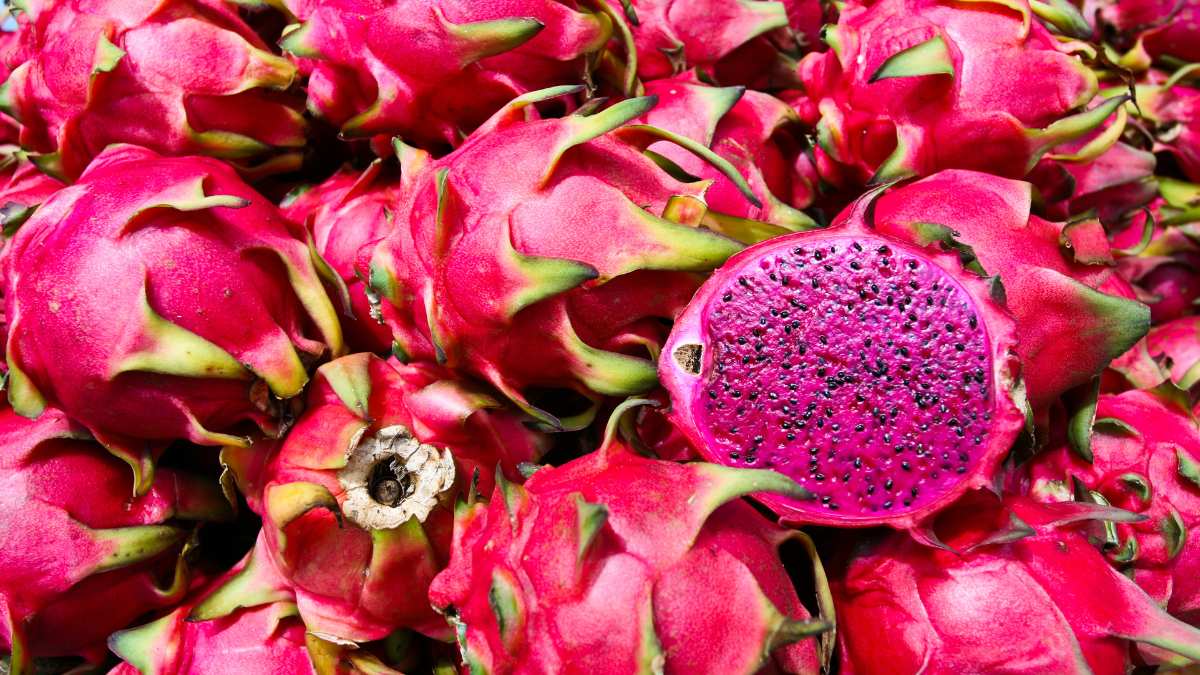
Dragon fruits are generally easy to grow and care for, but they can still encounter some problems, pests and diseases that can affect their health and yield. Some of the common issues that dragon fruit growers face are:
Sunburn:
This occurs when the dragon fruit plants are exposed to too much direct sunlight, especially during hot and dry seasons. The symptoms include yellowing, browning, or cracking of the skin or flesh of the fruits. To prevent sunburn, you can provide some shade for your plants during the hottest hours of the day or apply a thin layer of wax or sunscreen on the fruits.
Rot:
This occurs when the dragon fruit plants are overwatered, poorly drained, or infected by fungi or bacteria. The symptoms include wilting, softening, or blackening of the stems, roots, or fruits. To prevent rot, you can water your plants only when the soil is dry, improve the drainage of your soil, and remove any infected parts as soon as possible. You can also apply fungicides or bactericides to treat the infection.
Pests:
Some of the common pests that attack dragon fruit plants are mealybugs, scale insects, spider mites, thrips, and ants.
These pests can suck the sap from the plants and cause damage or disease. The symptoms include curling, yellowing, or dropping of the leaves or honeydew secretion on the stems or fruits. To prevent pests, you can inspect your plants regularly and remove any pests by hand or with a blast of water. You can also use natural predators such as ladybugs or lacewings to control the pests. You can also apply insecticides or neem oil to kill the pests.
Diseases:
Some of the common diseases that affect dragon fruit plants are anthracnose, stem canker, leaf spot, and mosaic virus. These diseases are caused by fungi or viruses that can infect plants through wounds or insects.
The symptoms include spots, lesions, blisters, or streaks on the stems, leaves, or fruits. To prevent diseases, you can keep your plants healthy and stress-free by providing adequate water, nutrients, and air circulation. You can also prune any damaged or diseased parts and dispose of them properly. You can also apply fungicides or virus inhibitors to treat the infection.
Dragon fruit side effects
Dragon fruit is generally safe to eat and has many health benefits, but some people may experience some side effects from consuming it. Some of the possible side effects are:
- Allergic reactions: Although rare, some individuals may be allergic to dragon fruit or its components. The symptoms may include swelling of the tongue, hives, and vomiting. If you have a history of food allergies, you should consult your doctor before eating dragon fruit or avoid it altogether.
- Stomach discomfort: Dragon fruit contains natural fiber, which can help promote healthy digestion. However, eating too much fiber can cause bloating, gas, or diarrhea. To prevent this, you should eat dragon fruit in moderation and drink plenty of water.
- Oxalate content: Dragon fruit contains oxalates, which are compounds found in certain fruits and vegetables. Oxalates can bind to calcium and form kidney stones in some people who are prone to them1. If you have a history of kidney stones or other kidney problems, you should limit your intake of dragon fruit or avoid it altogether.
- Interference with medications: Dragon fruit may interact with some medications, such as blood thinners or diabetes drugs. This is because dragon fruit can affect blood clotting and blood sugar levels. If you are taking any medications, you should check with your doctor before eating dragon fruit or monitor your blood levels closely.
- Environmental contaminants: Dragon fruit may be exposed to pesticides or other chemicals during cultivation or transportation. These contaminants can have negative effects on your health if ingested in large amounts. To reduce this risk, you should wash the fruit thoroughly before eating it or choose organic varieties whenever possible.
Dragon Fruit’s Popularity on Social Media
Dragon fruits have gained immense popularity on social media platforms, especially among food and wellness enthusiasts. Instagram feeds are filled with stunning photos of dragon fruit smoothie bowls, colorful fruit platters, and creative culinary creations.
Their vibrant hues and exotic appearance make them a perfect subject for captivating food photography. So, don’t be surprised if you come across captivating dragon fruit content while scrolling through your favorite social media channels.
Dragon Fruit as a Natural Food Coloring
Did you know that dragon fruit can be used as a natural food coloring? Its vibrant pink or magenta flesh can add a beautiful hue to various dishes, desserts, and beverages. By incorporating dragon fruit into your recipes, you can achieve visually stunning and naturally colorful creations, all while enjoying the unique flavor and health benefits it offers.
Dragon Fruit as a Vegan Ice Cream Alternative
For those following a vegan or dairy-free lifestyle, dragon fruit can be a fantastic ingredient for creating creamy and delicious ice cream alternatives. When blended with frozen fruits, plant-based milk, and a touch of sweetness, dragon fruit transforms into a luscious base for homemade vegan ice cream. So, embrace the magic of dragon fruit and enjoy guilt-free frozen treats.
Dragon Fruit’s Role in Traditional Medicine
Beyond its culinary allure, dragon fruit has also found its place in traditional medicine practices. In certain cultures, dragon fruits are believed to possess medicinal properties and have been used for various purposes. While scientific research is still ongoing to fully explore their potential health benefits, dragon fruits have been associated with properties such as anti-inflammatory, antioxidant, and immune-boosting effects.
Sustainable Farming Practices for Dragon Fruit Cultivation
As the demand for dragon fruits continues to rise, it’s crucial to promote sustainable farming practices for their cultivation. Sustainable farming methods aim to minimize environmental impact, conserve resources, and prioritize the well-being of both the plants and the surrounding ecosystem. Embracing organic farming techniques, efficient water management, and responsible pesticide use can contribute to the sustainable growth of dragon fruit farms.
Dragon Fruit’s Cultural Significance
Dragon fruits hold cultural significance in various regions where they are grown. They are deeply rooted in the traditions and folklore of these communities, often symbolizing luck, prosperity, and fertility. Exploring the cultural significance of dragon fruits adds an extra layer of appreciation for these captivating fruits.
I hope you’ve gained a deeper understanding of these enchanting fruits. From their diverse varieties and nutritional benefits to growing tips, harvesting techniques, and culinary possibilities, dragon fruits have captivated our taste buds and sparked our curiosity.
Conclusion
Dragon fruits have undoubtedly taken the culinary world by storm with their exotic beauty, luscious flavor, and numerous health benefits. From their captivating appearance to their refreshing taste and versatility in various recipes, these tropical gems have won the hearts of food enthusiasts and health-conscious individuals alike.
We’ve explored the different types and varieties of dragon fruits, learned about their nutritional and health benefits, discovered how to grow and care for dragon fruit plants, and indulged in the art of harvesting and consuming these delectable fruits.
Along the way, we’ve uncovered their cultural significance, explored their role in social media, and even ventured into their potential as a natural food coloring and vegan ice cream alternatives.
Dragon fruits are not only a feast for the senses but also a source of culinary creativity and a gateway to exploring new flavors and textures. Whether you enjoy them fresh, blended into smoothies, incorporated into vibrant salads, or as a unique addition to various dishes, dragon fruits offer a delightful and unforgettable experience.
In a world where culinary exploration knows no bounds, dragon fruits stand out as a delightful and captivating choice. So, go ahead, indulge in the magic of dragon fruits, and let them transport you to a world of tropical flavors and endless possibilities. Bon appétit!
FAQ
Can cats eat dragon fruit?
Yes, cats can eat dragon fruit, but it is not recommended to feed them this fruit regularly. Dragon fruit is not toxic to cats, but it does not provide any nutritional benefits for them either.
Cats are obligate carnivores, which means they need meat to get all the essential nutrients they require. Dragon fruit and other fruits are high in sugar and fiber, which can cause digestive problems for cats if eaten in large amounts. Some cats may also be allergic to dragon fruit or its components, and experience symptoms such as swelling, hives, or vomiting .
Therefore, it is best to limit your cat’s intake of dragon fruit and other fruits to occasional treats or avoid them altogether. If you do offer your cat some dragon fruit, make sure to wash it thoroughly and remove the seeds, as they can be a choking hazard for your cat. Also, monitor your cat for any signs of adverse reactions or discomfort after eating the fruit. If you notice any unusual symptoms, contact your veterinarian immediately.
How long does dragon fruit last?
Dragon fruit can last for about a week at room temperature or up to two weeks in the refrigerator. You can tell if the fruit is ripe by looking at its skin color and feeling its texture. The skin should be bright and even, and the fruit should have a slight give when pressed.
If the skin is dull, wrinkled, or soft, the fruit is overripe and should be discarded. You can also freeze dragon fruit for up to six months. To freeze dragon fruit, cut it into pieces and place them in a freezer-safe bag or container. Thaw the fruit in the refrigerator before eating or using it in recipes.
What does dragon fruit taste like?
Dragon fruit has a mild and slightly sweet taste that resembles a cross between a kiwi and a pear. The texture is similar to a kiwi, with tiny black seeds that are edible and crunchy. The flavor can vary depending on the variety and ripeness of the fruit. Some varieties are sweeter or tangier than others.
The yellow dragon fruit is usually the sweetest, while the red dragon fruit has a more tart flavor. The pink dragon fruit is somewhere in between, with a mellow and refreshing taste. Dragon fruit can be eaten alone or paired with other fruits, yogurt, granola, or honey for a delicious snack or dessert.
